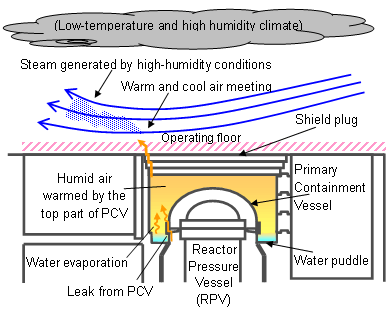- F. Daiichi’s high-efficiency water treatment system resumed operation on Friday. The three stream process (acronym ALPS) was suspended last Wednesday because a crane broke down. The crane removes and replaces contamination-filled containers on the system’s outlet. As it turns out, one of the crane’s four motors failed, but the company decided to be ultra-cautious and check everything before continuing with use of the other motors. The other three motors were found to be fully functional and the three-stream system was restarted. Although operating at full capacity, ALPS is technically in a “test” mode. This test run is expected to end in April. Although the system has operated smoothly for a month-and-a-half, Japan’s Press continues to foment uncertainty by reporting “it remains unknown whether the system can operate reliably”. (NHK) http://www3.nhk.or.jp/nhkworld/english/news/20140110_38.html
- Tepco has taken umbrage with foreign Press and internet reports on unit #3 “steam” emanations. The company has posted a news release addressing the actual cause of the barely-visible wafting, irresponsible speculations of underground explosions on December 31, and an excellent graphic explaining the source of the visible little cloud of condensation. Here’s the graphic…
The Press release can be viewed here… http://www.tepco.co.jp/en/announcements/2014/1233524_5932.html
- The F. Daiichi site boundary exposure level has risen above the 1 mSv/year national standard. A few locations on the site’s property boundary are at about 7.8 mSv/year. The reason is the large number of wastewater storage tanks, some of which are not far from the security fence. Part of the increased radiation level is due to contamination in the tank waters. However, a little-known phenomenon has amplified the detected levels. When Beta (β) radiation interacts with steel, it stimulates what is known as the Bremsstrahlung effect. The result is the emission of x-ray radiation. While β particles cannot pass through the tank’s metal, x-rays can go through the walls because they are comprised of pure energy and will penetrate materials. Most of the radiation increase at the site boundary since last March is due to x-ray, caused by the Bremsstrahlung phenomenon. The Nuclear Regulation Authority wants a timeline from Tepco to determine when the site boundary level will be returned to below 1 mSv/year. http://mainichi.jp/english/english/newsselect/news/20140111p2g00m0dm018000c.html
- The issue of Cesium-contaminated fish has renewed. One Black Sea Bream was caught at the mouth of the Niidagawa River, 37 kilometers south of F. Daiichi, with a Cesium level of 12,400 Becquerels per kilogram. The national standard for consumption is 100 Bq/kg. The fish was caught on November 17. Thirty seven Bream were caught, in total, but only one registered at 12,400 Bq/kg. Two others exceeded the limit at 426 Bq/kg and 197 Bq/kg respectively. The other 34 were below the limit, according to the Fisheries Research Agency. As a result, all Bream have been restricted from sale and restricted from being fished off Fukushima and Miyagi Prefectures. http://ajw.asahi.com/article/0311disaster/fukushima/AJ201401110029
- Nahara Town residents have petitioned for a plebiscite on building a low-level waste storage facility. The number of valid signatures exceeded the one-fiftieth criterion required for submittal to the town’s mayor, Yukiei Matsumoto. The mayor must now convene a municipal assembly and draft an ordinance to be voted on. It seems the mayor has veto power, but it is unlikely that Matsumoto will invoke it. Petition group leader Keiichi Matsumoto said he opposes the waste facility because it would be a disincentive to repopulation. There are 2,151 valid signatures on the petition out of a population of 8,230. Nahara is one of the two host communities for the undamaged Fukushima Daiini station 10 kilometers south of F. Daiichi. http://jen.jiji.com/jc/eng?g=eco&k=2014011000341
- A study of tsunami-caused fires in March, 2011 has been posted. The Japan Association for Fire Science and Engineering has compiled the first detailed analysis of the 371 fires spawned by the quake/tsunami of 3/11/11. While tsunami-spawned fire are considered atypical, the 3/11/11 tsunami produced more than 40% of the blazes cause by the surging torrent. The Association found that 371 fires erupted due to the quake and tsunami, with 159 due to the tsunami alone. The blazes stretched along a 610 kilometer coastline from Hachinohe, Aomori Prefecture in the north, down to Asahi, Chiba Prefecture in the south. The flames consumed more than 78 hectares of property in Iwate, Miyagi and Fukushima Prefectures, all of which bore the brunt of the water surge. This is greater than the 64 hectares of property immolated by the Great Hanshin Earthquake of 1995, which devastated much of Kobe City. By Prefecture, there were 99 tsunami-spawned fires in Miyagi, 29 in Iwate, 12 in Fukushima, 9 in Ibaraki, and five each in Aomori and Chiba. 35% of the fires were buildings, more than 60% of which were non-wooden. 31% of the fires were because of vehicles. The fire origins were likely liquefied gas cylinders, vehicular fuel cells, and natural gas lines which burst as buildings were swept away from their foundations. It was also noted that 212 fires were caused by quake aftershocks. http://ajw.asahi.com/article/0311disaster/analysis/AJ201401130067


